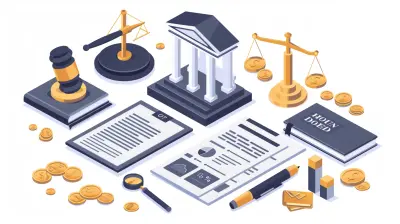When and How to Refinance Business Debt
15 August 2025
Imagine your business is a ship. You've set sail, you're charting the waters, and your crew is working their hearts out. But there's one little problem: an anchor. It's your business debt, and while it helped you get afloat, now it's slowing you down. You're wondering—is there a way to lighten the load, maybe swap out that old rusty anchor for something more aerodynamic?
Yep. That’s where refinancing comes in. It’s not just a fancy finance term—it could be your ultimate power move. But here's the kicker—timing and strategy are everything.
In this article, we're pulling back the curtain on when and how to refinance business debt. We'll talk about the signs, the steps, and the traps to avoid. And we’ll do it all in plain English because, let’s be real, finance shouldn’t sound like a different language.
What Is Business Debt Refinancing, Really?
Before we dive into the "when" and "how," let’s clear up what we're even talking about.Refinancing business debt means replacing your current debt with a new one—ideally on better terms. Think lower interest rates, longer repayment periods, or just getting rid of multiple loans in favor of one manageable monthly payment.
It’s like hitting the reset button on your financing but with more perks.
Why Do Businesses Refinance Debt?
You might be wondering, “Why go through the hassle?” Well, businesses do it for a bunch of smart reasons:- Lower Interest Rates – This is the big one. A better rate means less money out the door every month.
- Improved Cash Flow – When payments drop (or get stretched out), you free up cash for hiring, marketing, or even R&D.
- Simplified Finances – Consolidate multiple loans into one and spare your brain from juggling a dozen different due dates.
- Credit Score Boost – If your credit score has improved since you took out the original loan, refinancing might unlock better terms.
- Adjusting Loan Terms – Maybe short-term stress is killing your cash flow, or maybe you want to pay off debt faster. Refinancing can flex to fit your goals.
But—and this is key—refinancing isn’t always a slam dunk.
When Should You Refinance Business Debt?
Timing matters. Refinance too soon or too late, and you might make things worse instead of better. Here's when it makes sense to hit that refinance button:1. Your Credit Score Has Significantly Improved
Say you started your business with a meh credit score. Now, a couple of years in, things are looking up. Vendors trust you. You’ve never missed a payment. Your credit score isn’t just better; it's glowing.This is prime time to refinance. Lenders love good credit. It’s your golden ticket to unlock lower interest rates.
2. Market Interest Rates Have Dropped
Interest rates aren’t static—they’re like waves. If the market is experiencing historically low rates, refinancing could save you a significant chunk of change—especially if your current rate is older and outdated.3. Your Business Is More Financially Stable
Early on, you might’ve taken on high-interest loans just to stay afloat. But now you’ve got steady cash flow, inventory’s moving, and your customers are loyal.In this more stable phase, you can approach lenders with confidence. You’re not the same risk you were before, and lenders recognize that.
4. You've Got Too Many Loans to Track
If you're drowning in debt chaos—credit lines, equipment loans, merchant cash advances—consolidating through refinancing could simplify your life and potentially lower your overall payments.It’s like Marie Kondo-ing your business finances.
5. You're Planning for Growth
If scaling is on the horizon—new locations, new staff, more products—you need access to cash. Refinancing can help by lowering your monthly obligations, giving you more room to invest in growth.
When Not to Refinance
Not every moment is the right moment. Sometimes it’s smarter to wait or avoid altogether.- Prepayment Penalties – Some loans come with clauses that slap you with fees if you pay them off early. Always read the fine print.
- Worsened Financial Position – If your business is struggling or your credit score has taken a hit, lenders might either reject you or offer worse terms.
- Short Time Remaining on Current Loan – If you're close to the finish line with your current loan, refinancing might actually cost more in fees and interest in the long run.
- Interest Rates Have Gone Up – If today’s rates are higher than what you've currently got, refinancing could be like jumping out of the frying pan and into the fire.
How to Refinance Business Debt Like a Pro
Alright, so the stars have aligned. You’re ready to refinance. But how the heck do you do it?Here’s a no-fluff, step-by-step roadmap.
Step 1: Know Your Current Loan Details
You wouldn’t try to fix a leaky pipe without knowing where the water’s coming from, right? Same idea here. List out:- Current loan balances
- Interest rates
- Remaining repayment terms
- Monthly payments
- Any penalties or fees
This gives you a clear picture of what you're working with.
Step 2: Check Your Credit Reports
Yes, your personal and business credit reports. Lenders will comb through these like Sherlock Holmes looking for clues, so you better know what they’re seeing.If there are errors, fix them. If your score is in the danger zone, pause. Consider waiting or working to bump it up before you refinance.
Step 3: Shop Around for Lenders
Don't go with the first lender that says “yes.” That’s like marrying someone after one date. Compare:- Banks
- Online lenders
- Credit unions
- Alternative lenders
Look for better interest rates, lower fees, or more flexible terms. Read the fine print like your financial health depends on it—because it does.
Step 4: Choose the Right Type of Refinancing
Here's where it gets tailored to your needs. You’ve got options:- Term Loan Refinance – Replace your loan with a new fixed-term loan.
- Business Line of Credit – More flexible than a fixed loan, but handle with care.
- SBA Loans – Harder to get, but insanely low rates if you qualify.
- Debt Consolidation Loans – Roll multiple debts into one easy-to-manage obligation.
Each has pros and cons. It boils down to what fits your business goals.
Step 5: Apply and Submit Paperwork
Gather your documentation—tax returns, bank statements, financial reports, and proof of revenue. Lenders need to see you’re legit.This isn’t the time to be messy. Keep it organized, professionally presented, and accurate.
Step 6: Review the Offer Carefully
Great—you got an offer! Now? Don’t rush. Go over every detail—rates, fees, terms, penalties. If anything smells fishy, ask questions. Better yet, have a financial advisor or lawyer give it a once-over.Step 7: Close the Deal and Celebrate (Smartly)
Sign the paperwork, set up your new payment schedule, and officially close out your old loans. You're all set.Just remember that refinancing isn’t a magic wand. It’s a tool. Use the new breathing room to grow, not to impulse buy a ping pong table for the break room.
Hidden Pitfalls to Avoid
Let’s be real—refinancing sounds amazing, but it can backfire if you're not careful. Here are some traps that can sneak up on you:- Extending Your Terms Too Much – Sure, lower monthly payments are great, but if you stretch your loan 10 more years, you might end up paying more overall.
- Taking on Too Much Extra Debt – Don’t refinance and then start borrowing again recklessly. That’s like cleaning your house and immediately spilling red wine on the carpet.
- Ignoring Fees – Origination fees, legal fees, application fees—these can add up. Know the cost before you commit.
Questions to Ask Yourself Before Refinancing
Before you sign on any dotted line, ask:- Will this improve my monthly cash flow?
- Will I actually pay less over time?
- Are the terms better than what I have now?
- What’s the total cost, including fees?
- Will this help my business grow—or just delay financial problems?
The Bottom Line
Look, refinancing business debt isn’t some get-rich-quick card you pull out when things get tough. It’s a strategic move—one that can pay off big when timed and executed right.If your business is in a stronger place than when you took on your current debt, if the market conditions are in your favor, or if your loans are dragging you down—refinancing might just be the financial face-lift your business needs.
But take your time. Ask the hard questions. Run the numbers. Because done right, refinancing won’t just keep your ship afloat—it’ll help you sail faster, farther, and with way less stress.
all images in this post were generated using AI tools
Category:
Business FinanceAuthor:

Yasmin McGee
Discussion
rate this article
1 comments
Raelyn McTavish
Refinancing business debt can be a smart move to improve cash flow and reduce interest costs. However, timing is crucial—consider refinancing when interest rates drop or your credit improves. Always compare offers and assess the long-term impact on your business's financial health before making a decision.
September 4, 2025 at 12:59 PM

Yasmin McGee
Thank you for your insightful comment! Timing, market conditions, and thorough comparisons are indeed key to making informed refinancing decisions that can enhance cash flow and overall financial health.


